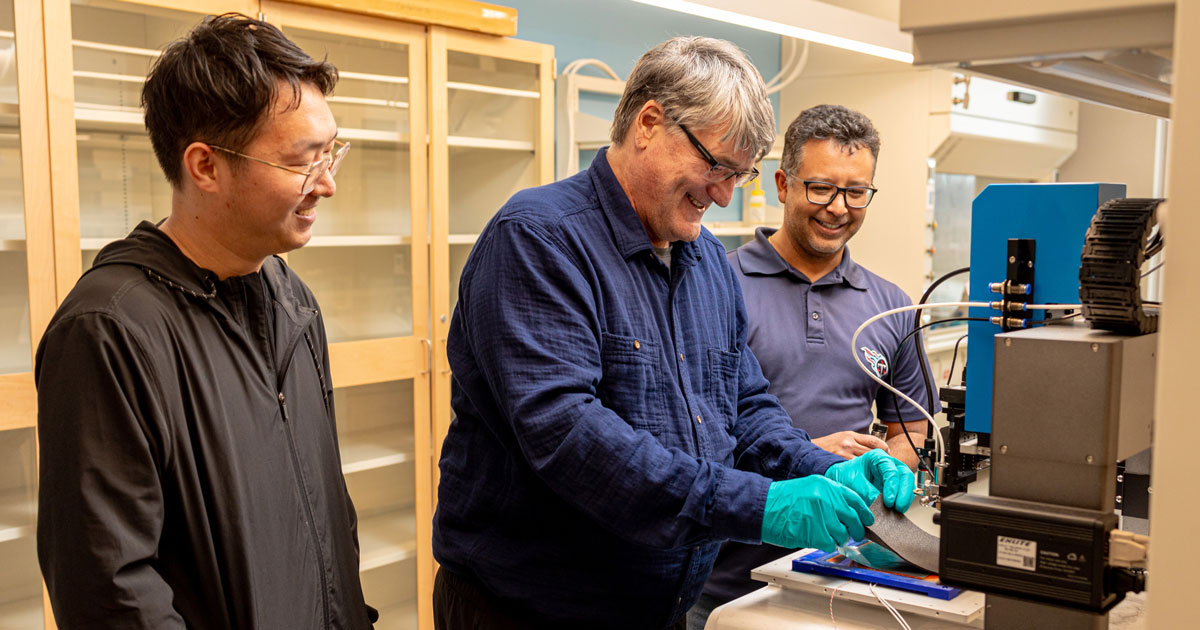UT Team Helps Nissan Find ‘Second Life’ for EV Batteries
The major selling point of electric vehicles has been their ability to reduce emissions while saving money through lower fuel costs. A potential impediment to this eco-friendly model of transportation is the shelf life of its power source.
EV batteries can no longer be used to drive electric vehicles when their charge capacity declines to about 70%. The batteries are expensive to produce and difficult to recycle or dispose of properly. Finding ways to repurpose them helps sustainability and minimizes the impact on the environment.
An engineering team from the University of Tennessee has been tasked with helping Nissan find a “second life” for its LEAF model electric vehicle batteries by turning them into power supplies at Nissan America’s Headquarters in Franklin, Tennessee. The Battery Energy Storage Solution (BESS) project also includes UT Oak Ridge Innovation Institute (UTORII), Middle Tennessee Electric, and 7 States Power Corp.
The collaborative effort across UT’s engineering departments is being led by UT-ORNL Governor’s Chair for Electrical Energy Conversion and Storage Tom Zawodzinski. He is joined on the team by Min H. Kao Department of Electrical Engineering and Computer Science Chancellor’s Professor Leon Tolbert; Material Science and Engineering Assistant Professor Katharine Page; and Peng Zhao, associate professor in mechanical, aerospace, and biomedical engineering at the UT Space Institute.
The UT team received funding through UTORII’s Science Alliance’s Program for Advancing Collaborative Teams (PACT) program, which has enabled each member to hire a graduate student to assist with the work.
Nissan is adding two second-life battery systems to help offset building power consumption and extend the use of electric vehicle batteries. The project repurposes Nissan LEAF batteries to store energy from the electrical grid when it is in lower demand, then supply it to the building when there’s a greater need or a higher energy cost from the grid. Called “energy peak shaving,” the process is like storing rainwater after a downpour to use on a garden during a drought.
The UT team is developing a rapidly deployable signature of what is happening to the material inside the battery so Nissan can test the battery’s different parts to assess the overall state of health. The goal is for Nissan to be able to remove poor performing cells or parts more quickly so that the second use power supply can run in more optimal state and provide power to the plate during peak demand.
“Our approach is probably unique in terms of really getting into the weeds of what is going on inside the battery while at the same time getting an external measurable,” Zawodzinski said. “That is the value of this multidisciplinary team I put together from UT filled with people who are experts in their field. We can all work together to give us the bigger picture.”

Collaborative Energy
Zawodzinski knows the chemistry and electrochemistry of the battery. Tolbert’s strength is understanding how the battery will interface with the power grid and other electrical aspects. Zhao is an expert in battery safety. Page specializes in determining the real atomic structure of materials, including how they change under use.
“Our role will be to try and link the different states of the battery degradation or performance with what is going on inside the anodes and cathodes and other important phases in the battery,” Page said. “We will collect the materials from inside the battery at different states of use and will characterize how the state of those correlate to the other figures of merit or metrics the team is extracting from battery technology.”
If successful, the project will have multiple benefits. Nissan will get more lifetime out of the EV batteries while improving the safety of the batteries with new and different methods of examination. The surplus power makes it cheaper and greener to charge the batteries, reducing the reliance on CO2-intensive generators during peak times. The BESS project is expected to reduce the Nissan office’s annual carbon dioxide emissions by 3.7 tons per year, according to Nissan.
“A lot of times renewables have fluctuating output,” Zawodzinski said. “The wind doesn’t blow, or the sun doesn’t shine all the time. This gives them an extra buffer if you will for those types of capabilities.”
The two battery installations will be extensively studied at Nissan America’s Headquarters for at least a year as the team compiles data.
Page is excited to work on a project that is practical and can help numerous users, manufacturers, and developers increase the utility or performance of a battery while providing an eco-friendly outcome.
“It’s something people are doing right now and using right now,” Page said. “There is a great need to make better use of this resource, so I am really excited to apply our x-ray, electron, and neutron tools to a problem that is of societal importance.”
Contact
Rhiannon Potkey (865-974-0683, rpotkey@utk.edu)
